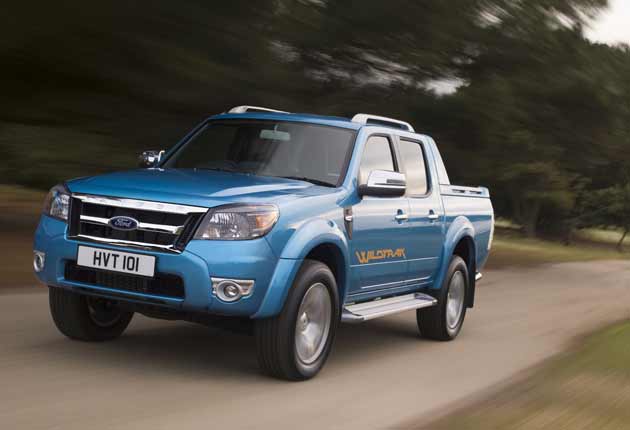Ford Ranger
The admirable new Ford Ranger – launched into a decidedly unhealthy market – does what it is designed to do

Your support helps us to tell the story
From reproductive rights to climate change to Big Tech, The Independent is on the ground when the story is developing. Whether it's investigating the financials of Elon Musk's pro-Trump PAC or producing our latest documentary, 'The A Word', which shines a light on the American women fighting for reproductive rights, we know how important it is to parse out the facts from the messaging.
At such a critical moment in US history, we need reporters on the ground. Your donation allows us to keep sending journalists to speak to both sides of the story.
The Independent is trusted by Americans across the entire political spectrum. And unlike many other quality news outlets, we choose not to lock Americans out of our reporting and analysis with paywalls. We believe quality journalism should be available to everyone, paid for by those who can afford it.
Your support makes all the difference.Americans love their pick-ups. Ford's F150 has in some years been the best-selling vehicle of any type in the US. Britons haven't had quite the same love affair with the genre, but a few years ago there was a sudden upsurge in the notion of truck as fashion accessory.
There was some Americana admiration going on here, even if the trucks concerned mainly wore Japanese badges. These Japanese pick-ups ape their US role models but are, naturally, smaller. That said, the US operations of Japanese companies make pick-ups just as giant as Ford's finest and the most macho of Dodge Rams. The Nissan Titan is as good an example as any.
Here, Nissan's contribution is called the Navara, and it's essentially a truck version of the Pathfinder SUV, complete with a huge front grille, outsize wheel arches and lashings of chrome. Mitsubishi's rival range includes one called Animal – the most overtly styled pick-up ever.
They may be downscaled relative to American pick-ups, but those we can buy here are still hefty, aggressive-looking things, able to say a lot more about their drivers than that they might be builders or farmers. A loophole, now closed, in company-car tax-assessment rules briefly made running a double-cab pick-up as a company car a very cost- effective idea, which fuelled their popularity among those of brash taste. Farmers and builders, meanwhile, being of more pragmatic outlook, merely continued to buy the basic versions, sometimes with useful four-wheel drive.
But it has all gone wrong. "The luxury double-cab segment has crashed," says Steve Kimber, commercial vehicles director at Ford of Britain, partly explaining why overall pick-up sales tumbled by 34 per cent in 2008 and have plummeted by another 30 per cent so far this year. Into this unhealthy market Mr Kimber is launching a new version of Ford's Ranger pick-up.
As before, the Ranger is made in Thailand in a joint venture with Mazda, and Ford US has had nothing to do with it other than to provide a little reflected F150 glory to those in the know. The Ranger comes as regular single cab, a super cab with a pair of rudimentary rear seats sufficient to transport workmen around a site, and the image-leading double cab with proper rear seats. The engine is a four-cylinder turbodiesel of either 2.5 or 3.0 litres; the former can be combined with either rear-wheel or four-wheel drive, the latter is 4x4 only. Trim levels are XL, XLT and the suitably macho Thunder and Wildtrak. Prices range from £15,410 to £25,128.
The Ranger may not be American but its chromium-plated nose and big-shouldered stance certainly hint at a Stateside gene pool. Inside, the plastics are hard and tough but there are trappings of indulgence: a fake leather gaiter for the stubby gear lever, metal-look rims for the overlapping instruments, and a properly integrated stereo.
It feels dated to drive, with lots of bouncing from the rear suspension, the low-frequency shudder of a rubber-mounted body moving on its separate chassis, comically little grip from the rear wheel in the wet, and the slowest-responding steering I've encountered in a while. But that's all typical of a truck. The 2.5-litre, 143bhp engine copes with the weight, the bigger engine with 156bhp makes the Ranger almost lively. Both are surprisingly smooth for diesels with four hefty cylinders, but rear passengers in the double-cab versions have a miserable time over bumps, especially in the Wildtrak with its lower-profile tyres on blingier wheels.
But the Ranger does what it is designed to do, admirably. That includes a refreshingly simple four-wheel drive system, with both 4x4 and the low ratio range manually selected. The system is for use only away from sealed roads, otherwise the solid locking together of front and rear axles would cause dreadful tensions in the transmission. Off-road, however, the Ranger proves close to unstoppable, helped by an anti-stalling device which automatically keeps the engine chugging away at 1,000rpm or so almost regardless of gradient. All you have to do is steer.
It's a pick-up. It works. The end.
The Rivals
Mitsubishi L200 Animal 2.5 Double Cab 4x4: £23,459.
One of many L200 variants. Very popular, striking-looking pick-up, rather more futuristic than the Ranger.
Nissan Navara Tekna 2.5 Double Cab 4x4: £22,948.
Smaller turbodiesel engine than Ranger Wildtrak but significantly more power and torque. Looks tough and imposing.
Toyota Hilux 3.0 Double Cab Invincible: £24,029.
Like the Ranger, looks more traditional than L200 and Navara, and offers a similar blend of toughness and simplicity.
Join our commenting forum
Join thought-provoking conversations, follow other Independent readers and see their replies
Comments